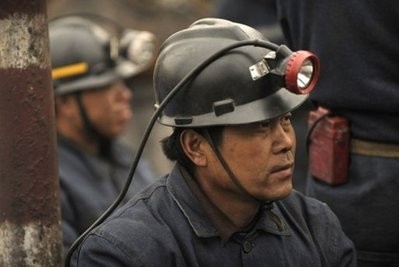BEIJING (AFP) – More than 110 workers were pulled out of a Chinese coal mine Monday over a week after being trapped by flooding, in what has been hailed as a miracle rescue in the notoriously dangerous industry.
So far, 114 workers have been brought out alive from the half-built Wangjialing mine in Shanxi province and taken to hospital for treatment, state television and the Xinhua news agency reported.

The news from Shanxi, where 153 workers became trapped when the state-owned mine flooded on March 28, was a rare bright spot for an industry known for its poor safety records and more than 2,600 deaths last year.
"How fantastic to be on ground again," Xinhua quoted one 27-year-old survivor as saying.
The head of the State Administration of Work Safety, Luo Lin, told China Central Television he was excited about the "two miracles" after the accident, which authorities blamed on lax safety standards at the mine.
"The first is that these trapped people have made it through eight days and eight nights -- this is the miracle of life. Secondly our rescue plan has been effective -- this is a miracle in China's search and rescue history," Luo said.
Shanxi governor Wang Jun said there was "still a possibility" that 38 others could be saved, according to the China News Service. The fate of the last worker in the massive pit remained unclear.
CCTV showed survivors being brought out of the pit one after another, strapped to stretchers and wrapped in green blankets. Towels covered their eyes and blackened faces to protect them from lights after so long underground.
Groups of rescue workers wearing blue and orange jumpsuits loaded them into scores of awaiting ambulances, while medical personnel dressed in white administered intravenous drips and oxygen.
Provincial Communist party chief Zhang Baoshun said he was told that most of the survivors were in stable condition, and could speak, Xinhua said.
Most of the survivors were rescued from a platform above which rescuers had drilled a hole last week, ensuring those trapped had oxygen, the report said. Glucose was also sent down to the workers.
Many were nevertheless severely dehydrated, and doctors also feared gas poisoning from the bad air in the shaft, CCTV said.
The Beijing News quoted rescue workers as saying they had seen bodies in the mine, but no details were given.
"I have not slept for several days," black-faced rescuer Wei Fusheng told state television as he wept with joy. "Our efforts have not been in vain."
Footage of the rescue scenes in Shanxi, China's coal producing heartland, played throughout the day as the country marked its annual "grave sweeping day," a national holiday to mourn the dead.
Thousands of people lined the road from the mine, applauding as ambulances carrying the first survivors rushed past, Xinhua said.
"I have two daughters and a son. I had to do mining work to earn money for them," said a 45-year-old survivor being treated in hospital.
At least 3,000 rescuers had been racing against time to pump water out of the mine. Rescuers only entered the shaft at the weekend but said there was more water than anticipated.
On Sunday night, a team of 100 rescue workers descended into the mine again and discovered the first nine survivors two hours later, before a second team was sent in. Up to 300 rescuers were in the pit by mid-morning Monday.
The accident occurred when workers apparently dug into an older adjacent mine that had been shut down and filled with water, press reports have said.
The work safety watchdog blamed the accident on the mine owner, the Huajin Coking Coal Company, which failed to heed repeated warnings that water was accumulating in the pit days before the disaster.
Workers had also been ordered to step up the pace of work in order to ensure that coal production began by October this year, the safety watchdog said.
Safety is often ignored in China's collieries in the quest for quick profits and the drive to meet surging demand for coal -- the source of about 70 percent of the country's energy.
Last week was disastrous for China's mining sector, with five separate accidents from the far-western Xinjiang region to the northeastern province of Heilongjiang. A total of 37 people were killed and 70 remain missing.






)

















